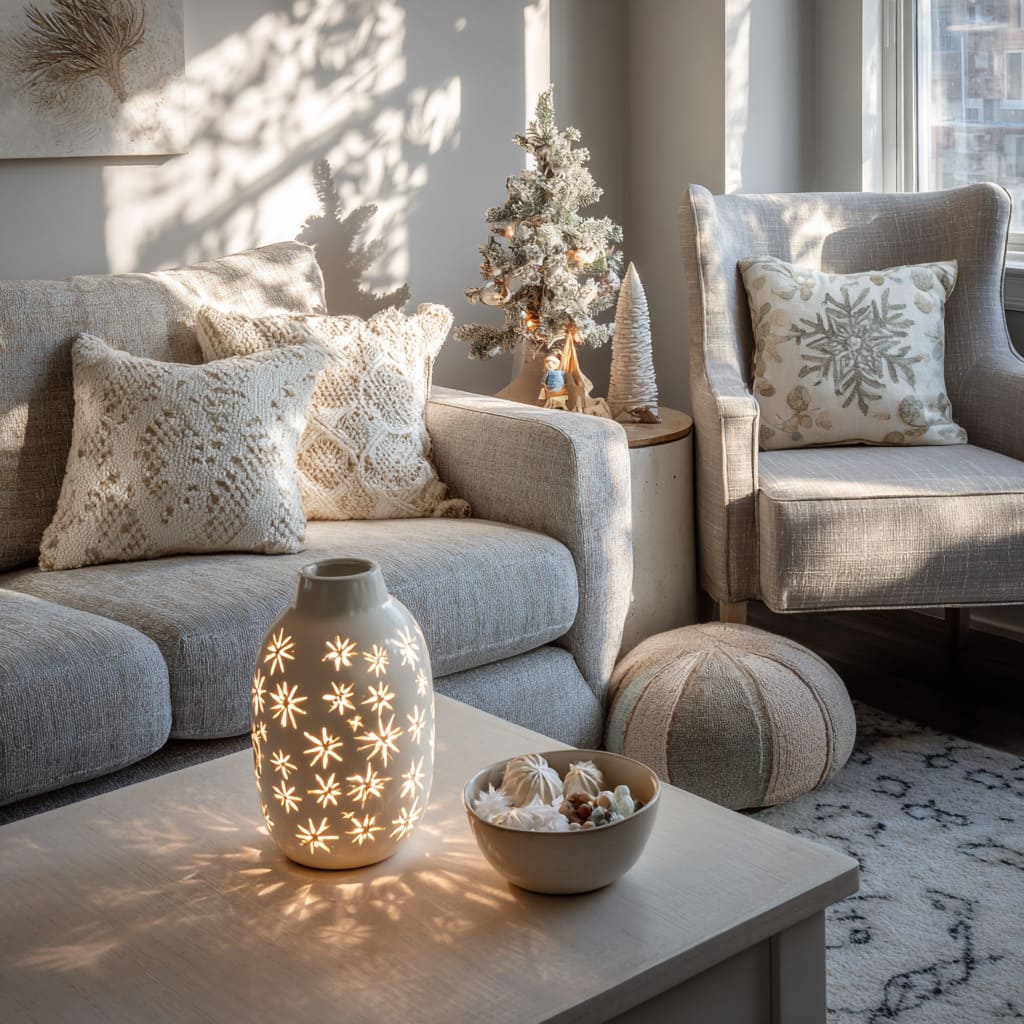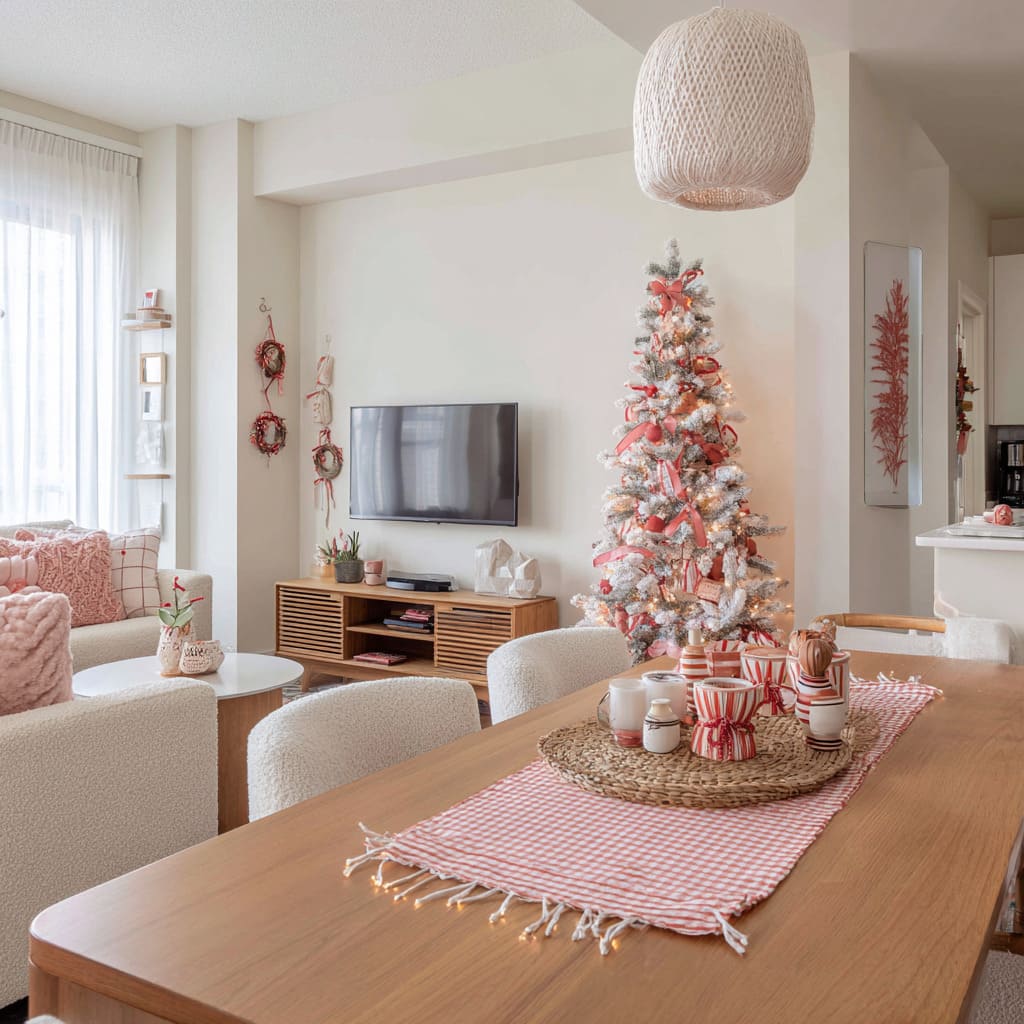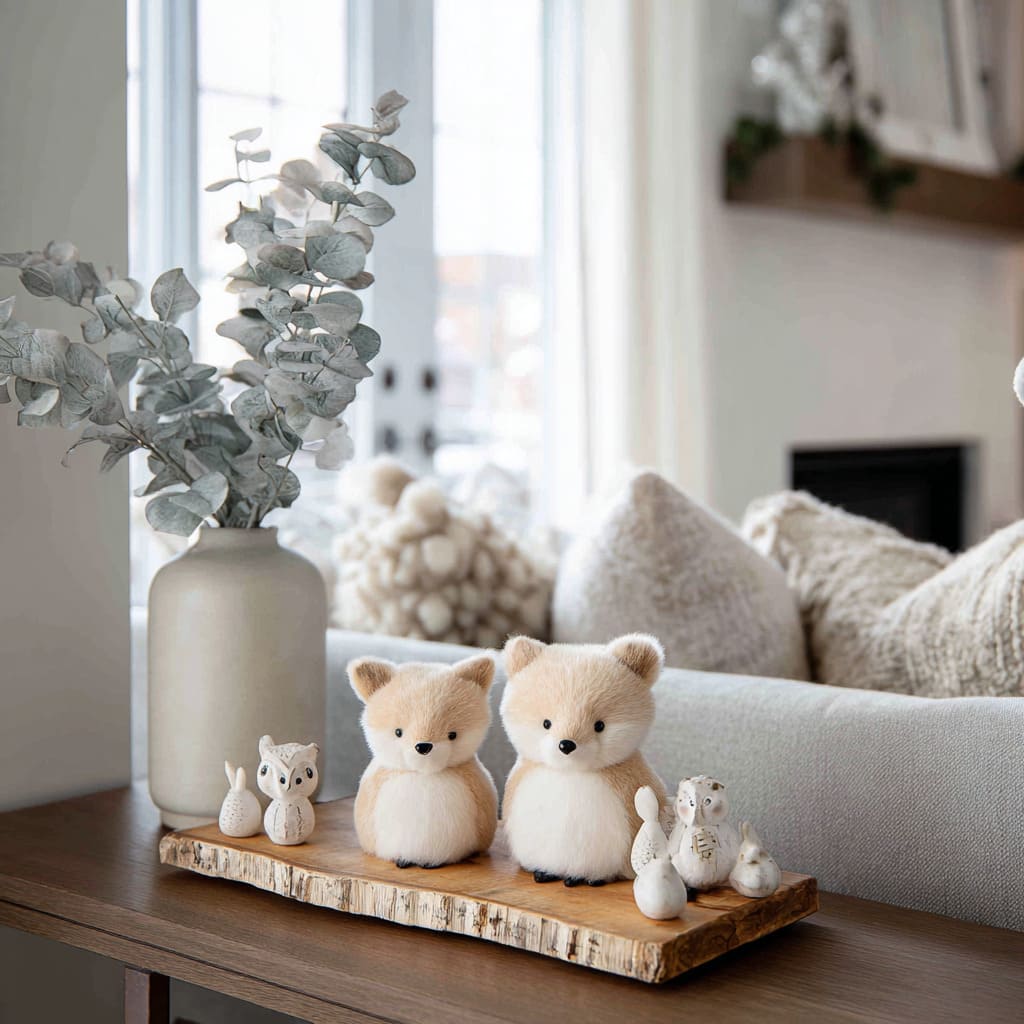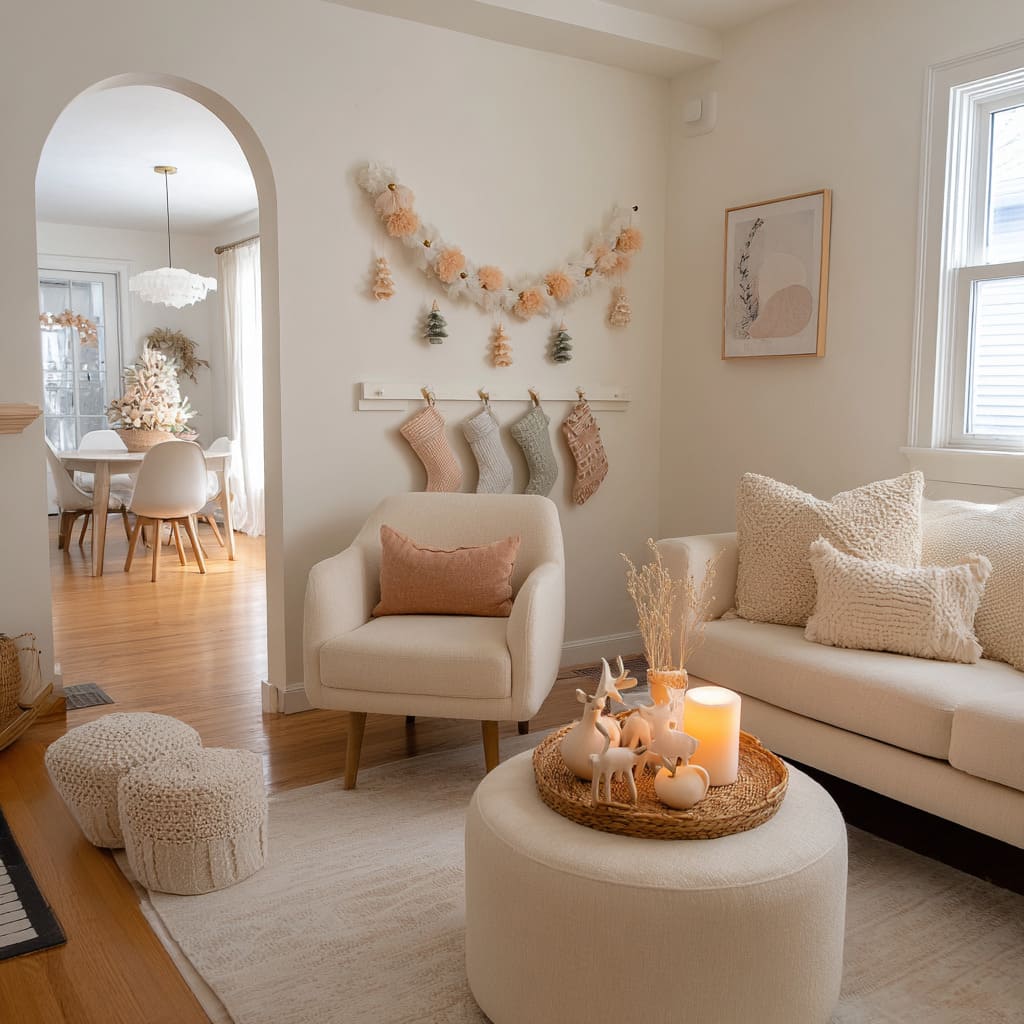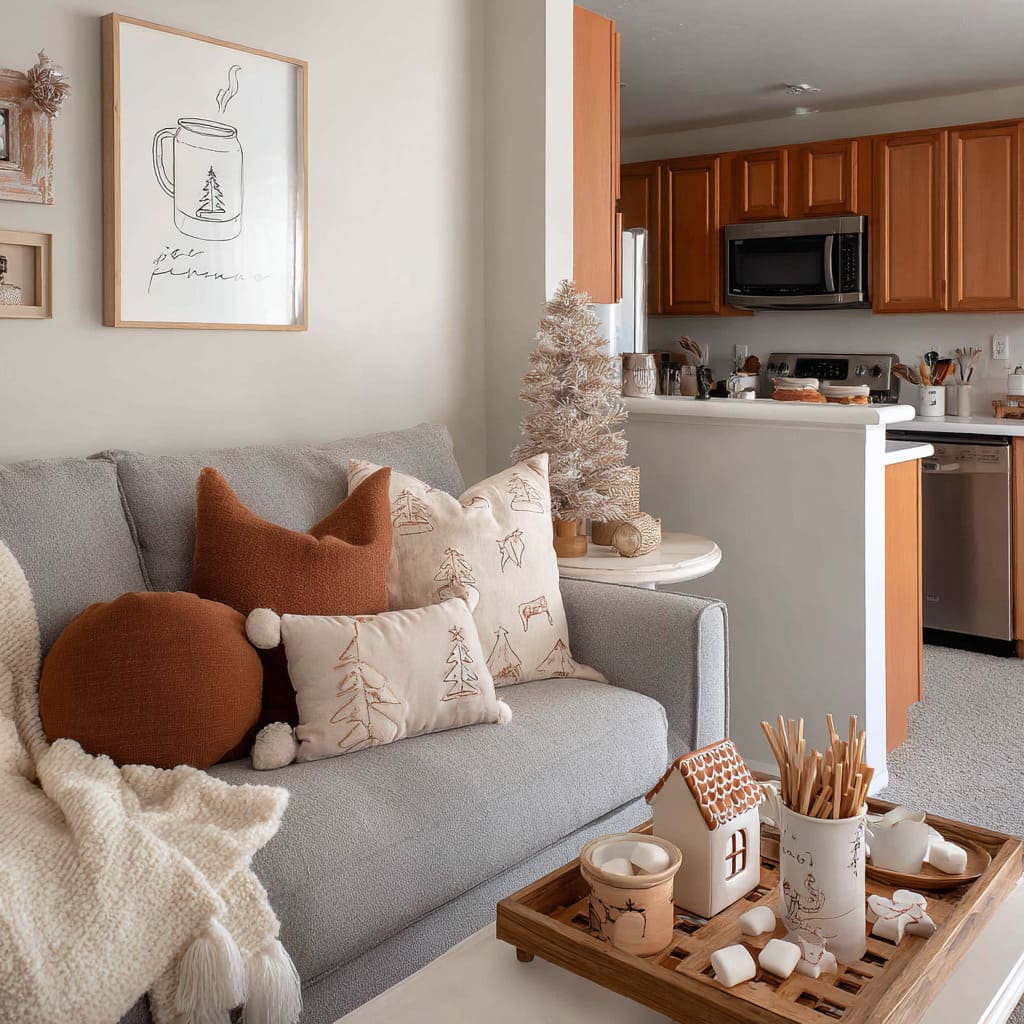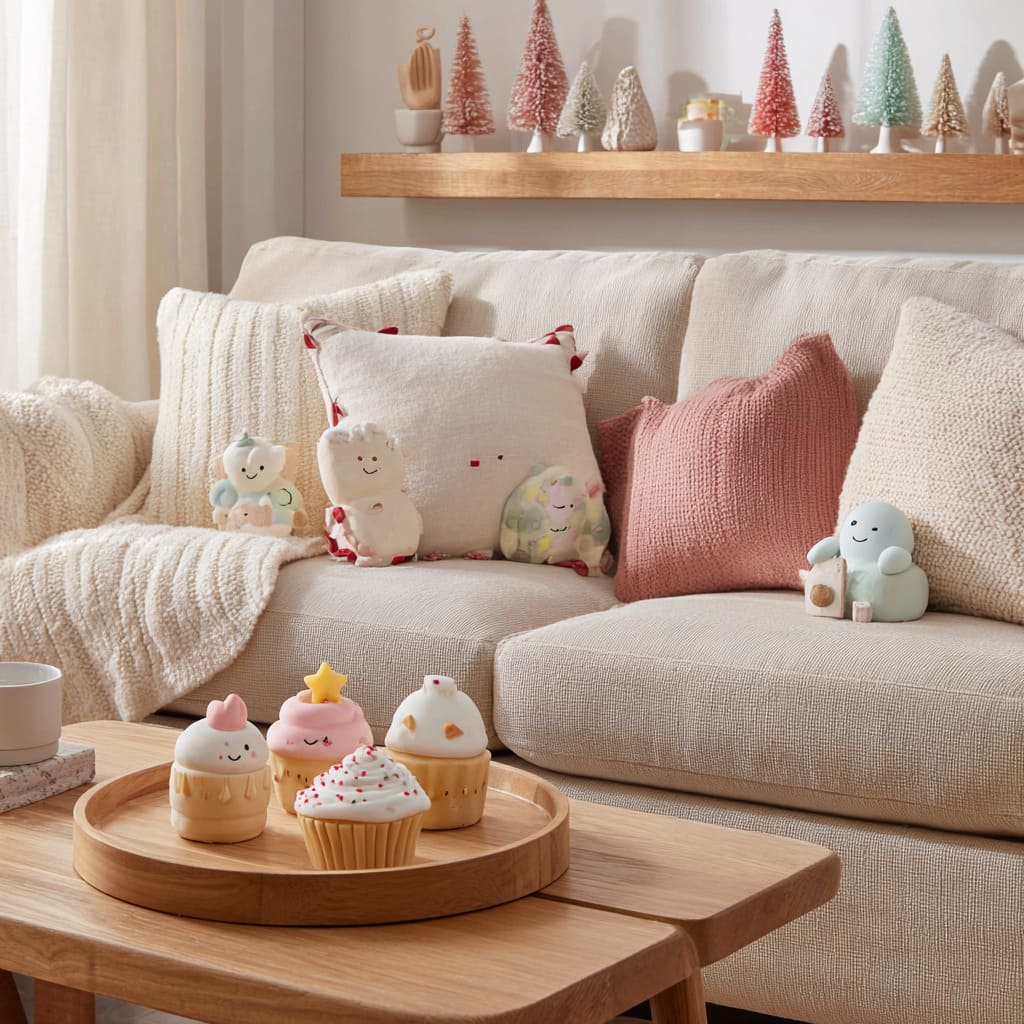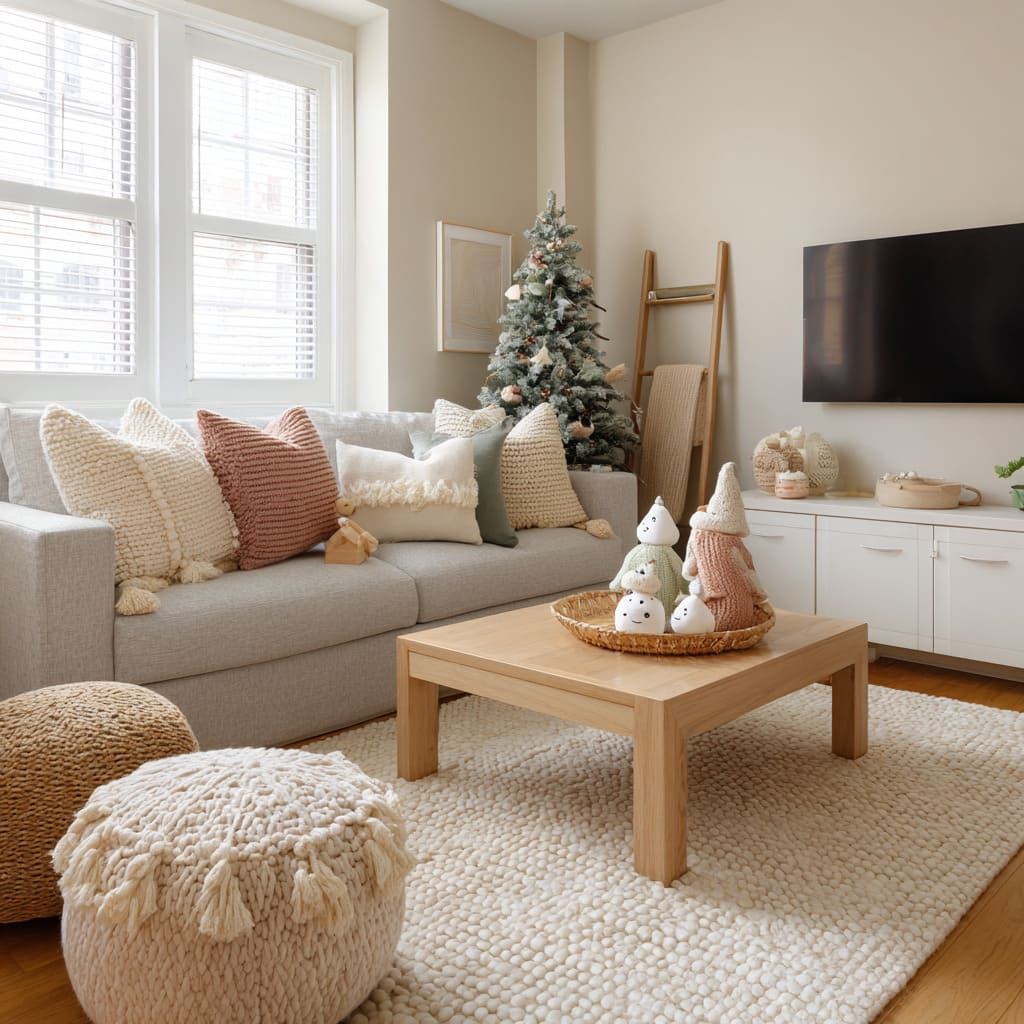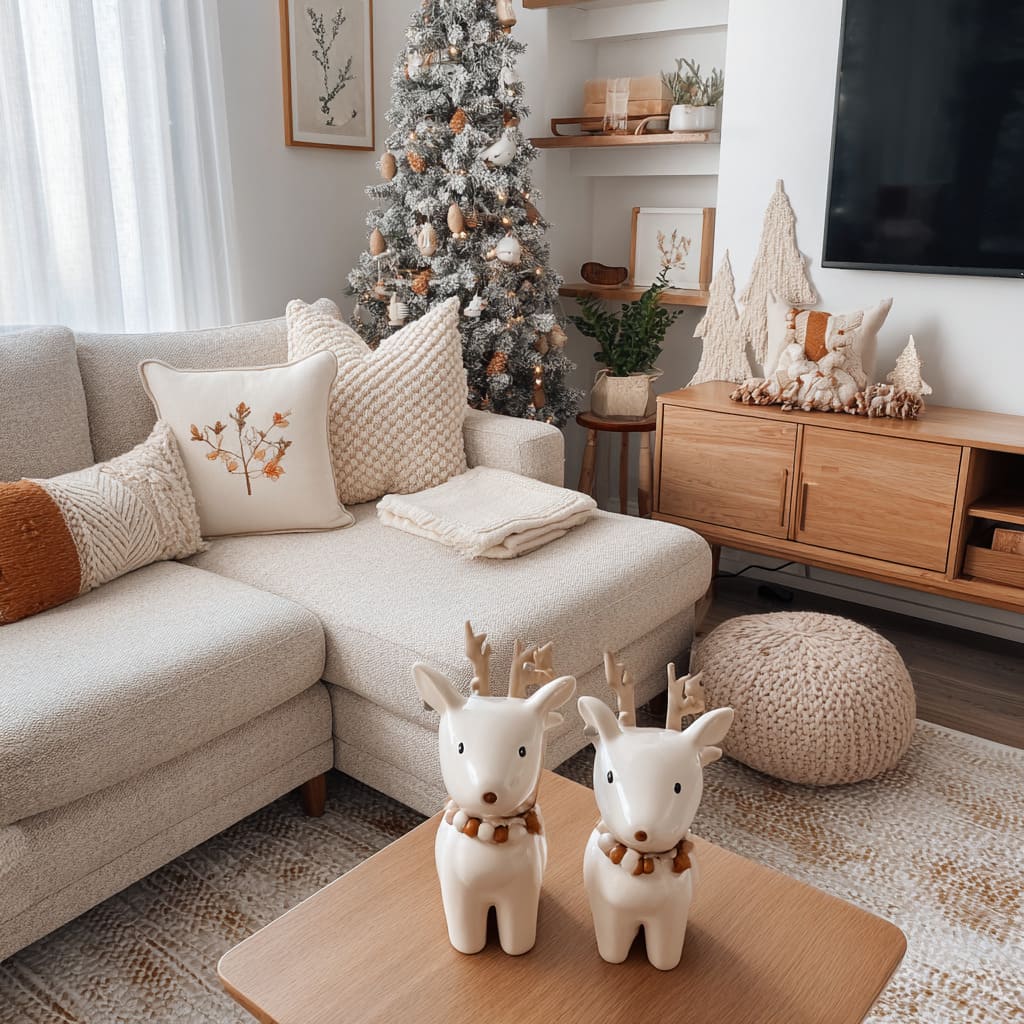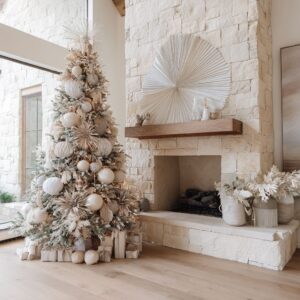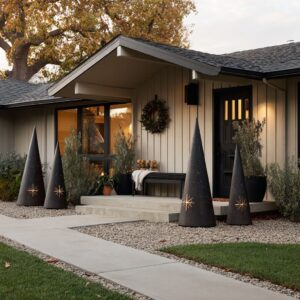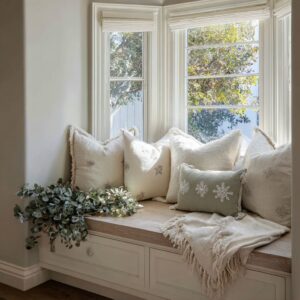A large portion of cute Christmas decorating ideas emerges from the simple shift in geometry used throughout a room. Rounded silhouettes take the lead: circular ottomans, knitted poufs shaped like soft snowballs, wool ornaments with puffy contours, plush pillows with curved corners, and soft-edged figurines.
These gentle shapes quietly replace hard lines, which is the foundation of the “cute” effect even before any seasonal detail enters the room. Thick tassels, wool pompoms, oversized knits, and felt spheres amplify the visual rhythm of softness.
The entire Christmas character can be built on this repeated language of rounded form—an approach that allows holiday styling to merge into the everyday palette. The repeating geometry becomes a subtle visual thread: one round pillow connects to round candle holders, the candle holders to snowball-like felt shapes, and those to dinnerware on a tray.
In interiors designed this way, even the tree ornaments adopt round or gently tapered silhouettes, ensuring consistency without depending on glitter or shine. The soft geometry also appears in hanging elements, such as plush star cushions floating overhead, turning vertical surfaces into cloud-like scenes.
This rounded architecture of objects creates an environment where cute accents feel natural rather than added, and the room becomes a place where the season unfolds through quiet shapes rather than strong color contrasts.
Character Groups and Micro-Scenes
Another important dimension of cute Christmas decorations iscan be the presence of small characters arranged in meaningful pairings or clusters. These are not scattered figurines but miniature social groups placed on trays, tables, benches, and console shelves.
Pairs of mice sitting on a wooden stool, two reindeer with wooden bead collars welcoming guests from the coffee table, families of plush foxes perched on the sofa, tiny snow-characters seated beside cone figures, and polar bears with knitted scarves resting near the fireplace—each ensemble behaves like a vignette in a picture book.
Their faces use minimal detail, often just a soft nose or tiny dot eyes, letting the charm come from their posture and placement rather than exaggerated expression. These small scenes act like emotional anchors in the room: a miniature forest floor with animals on a wooden slice, a tiny village protected under glass domes, or cupcakes and dessert-inspired ornaments forming a friendly centerpiece.
They usually sit at human eye level or interaction height, which helps them feel like participating guests rather than decorative objects. The overall effect is that holiday decorating becomes a form of storytelling, where the room functions as the environment and each character grouping contributes a chapter in a gentle seasonal tale.
Dessert Logic and Sweet Visual References
While traditional decorating often leans on bright colors or metallic shine, modern ideas rely on dessert cues to build the cute Christmas room look. Nearly every zone can hint at something edible: cupcake ornaments arranged in a tray like pastries in a bakery window, marshmallow-like pillows on cream sofas, cocoa mugs sketched in framed art, gingham table runners with tassels resembling candy wrappers, ceramic houses shaped like frosted gingerbread villages, and ribbon spirals that echo candy-cane stripes.
Instead of strong reds, the palette can stay soft—coral, blush, berry, and warm ginger—tones that feel like ingredients rather than pigment. This dessert-driven mood also appears in materials: woolen spheres resemble meringue drops, chunky knitted throws mimic icing piped across a cake, and pom-pom garlands drape like strings of confections.
Even tree decorations adopt the language of sweets by using matte finishes and gentle textures, letting the entire room feel edible without being literal. The sweetness never becomes overwhelming because each edible cue is muted by pale backgrounds, neutral furniture, and soft natural woods that keep the scene calm.
This approach forms a sensory theme where holiday styling feels like a cozy dessert table rather than a bold display.
Mini Forests, Villages, and Landscapes On Furniture Surfaces
One of the strongest visual strategies is the construction of small landscapes that transform consoles, ledges, benches, and shelves into tiny worlds. These scenes can often support a wider cute Christmas theme where bottle-brush trees become miniature forests, and ceramic house sets become tiny glowing neighborhoods.
The landscapes frequently follow a clear topography: tall trees on upper shelves suggesting mountain ridges, medium trees forming a middle layer on benches, and short figurines sitting on trays like valley floors.
A single central tree—either taller or more textured—provides a visual anchor, guiding the eye through the arrangement. The objects often have a handmade character: uneven ceramic walls, fuzzy fibers, or natural wooden bases.
This small irregularity keeps the scenes warm and personal rather than polished. Light plays a strong role in these miniature worlds, with tiny lanterns projecting soft patterns, glowing houses creating warm silhouettes, and natural daylight forming moving shadows behind trees.
A single furniture surface can become a self-contained winter environment: a woodland strip behind a sofa, a bakery-style vignette on a coffee table, or a long media wall transformed into a snowy village stacked over multiple shelf levels. These micro-landscapes are a defining part of how cute seasonal styling comes to life visually.
Powdery Palettes and Warm Neutrals as the Framework of Cute Styling
A key factor is the color strategy that allows the sweetness to remain refined. Instead of bright contrasts, cute palettes revolve around powdery and edible colors.
Neutrals such as cream, oatmeal, bone, and pale gray form the main visual field. These muted grounds serve as the perfect backdrop for soft greens, coral ribbons, caramel browns, and delicate berry accents.
The result is a palette that feels like winter confections rather than traditional holiday graphics. This color design allows the room to carry many objects while still feeling calm.
Reindeer, foxes, cupcakes, cone trees, gingerbread figures, and knitted pillows share similar tones, making the overall scene cohesive. Even when room designs use richer brown shades resembling baked gingerbread, the surrounding furniture and soft textiles keep the palette from becoming heavy.
Occasional hints of sage, dusty mint, or eucalyptus green pair naturally with wooden bases and matte ceramics. This color logic keeps the interiors gentle, grounded, and full of atmosphere without relying on bright saturation.
The combination of pale backgrounds and warm details creates the visual softness that seasons the room with a cute holiday identity.
Textiles as Seasonal Clothing: Layers, Stitches, and Touch-Friendly Forms
Textiles can behave like winter outfits for the furniture: thick cable-knit pillows resembling sweaters, throws with oversized tassels reminiscent of pom-pom hats, ribbed cushions shaped like everyday winter clothing, and boucle upholstery that mimics soft fleece. The textiles can create the majority of the holiday mood before any ornament appears.
Pillows lined up in gradients of blush, cream, sage, and caramel behave like characters themselves, forming warm gatherings across sofas.
Throws fall in relaxed drapes, echoing tree shapes or soft snowbanks, while poufs and knitted stools act as tactile snowballs on the floor. This approach ensures the season is visible through texture rather than shine.
It also connects beautifully with small figurines: polar bears setting near snowball bowls, plush animals resting on knit blankets, mice sitting near cushions with stitched stars, and gnomelike figures on woven trays. The tactile layering connects all these elements into a single soft visual ecosystem.
This textile-first approach supports cute ideas for Christmas decorations by allowing the room to feel festive through touch-friendly materials rather than complex ornamentation.
Light, Shadows, and Gentle Atmospheres
Light is quietly one of the strongest forces shaping the mood. Holiday glow can be created through soft sources rather than bright ones, turning the room into a calm winter haven.
A ceramic lantern casting a delicate pattern on the coffee table, warm lights hidden inside bottle-brush houses, tiny strings of lights draped casually over throws, and sunlight forming dancing tree shadows on the walls—each plays a part in creating depth and mood. The lights rarely sit directly on the surface of a tree branch; instead, they glow from within, giving trees a soft halo rather than sparkle.
Shelves lit from below create warm lines across a media wall, letting tiny village scenes appear as if they are floating. Even small candles become focal elements, especially when combined with dessert-like cues such as marshmallows or warm cocoa mugs.
Because the palettes stay gentle, the warmth of the light becomes the seasonal signature. This is especially noticeable in rooms built around woodland characters or nativity pieces, where the glow reinforces the story-like character of the scenes.
The gathered effect is a room where light behaves as a decoration itself, supporting cute Xmas ideas that rely entirely on charm, warmth, and a soft sense of winter presence.
Conclusion
Cute Christmas decorating grows from gentle shapes, soft textures, and tiny story scenes that feel warm rather than busy. When plush figures, dessert-like details, powdery colors, and miniature landscapes share the same calm palette, the room’s look gains a sweet seasonal mood that blends naturally with everyday furnishings.
Light, textiles, and small character groups do most of the work, letting the holiday atmosphere appear through softness and charm instead of bold displays.

